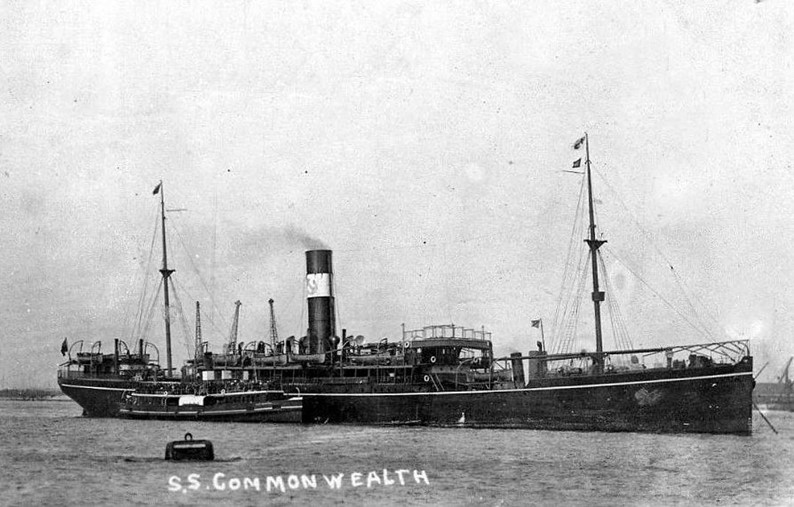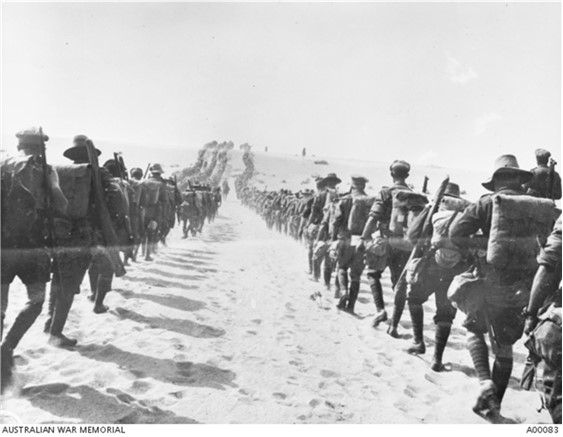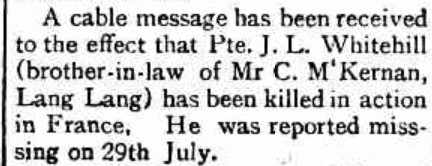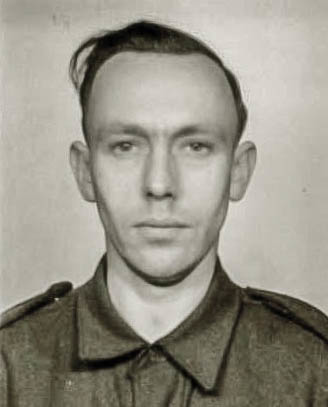John Alger WHITEHILL
Eyes brown, Hair dark brown, Complexion fresh
John Whitehill - “He was beloved by us all”
Can you help us identify John Whitehill?
John (Jack) Whitehill was killed in Action at Fromelles. As part of the 58th Battalion he was positioned near where the Germans collected soldiers who were later buried at Pheasant Wood. There is a chance he might be identified, but we need help. We are still searching for suitable family DNA donors.
In 2008 a mass grave was found at Fromelles, a grave the Germans dug for 250 (Australian) bodies they recovered after the battle.
If you know anything of contacts here in Australia or his relatives from Scotland or England, please contact the Fromelles Association.
See the DNA box at the end of the story for what we do know about his family.
Jack’s Early Life
John (Jack) Alger Whitehill was born in 1893 at North Melbourne, Victoria to Mark Hadley Whitehill and Violet Louisa (nee Reid). He was the second of their three children; Olive and Myrtle were born two years before and after him. Tragedy struck the family when Jack was just three - his father Mark died of heart failure at the age of 36. According to Jack’s Aunt, Victoria Staff, he was then raised by his grandparents John Francis and Sarah Whitehill, in Yackandandah, Victoria, 300 km northeast of Melbourne.
Jack’s mother remarried in about 1900 to William Campbell and they had a son, Horace Leslie Campbell. It is not known what role Violet played in her elder children’s lives. In 1914 and 1915 Jack was working as a labourer in Toolleen, which is between Bendigo and Echuca. Jack’s half-brother Horace also served in the War (Regimental No. 3537). When he enlisted, he stated his age as 18 instead of 17 because he was too young to join. He served in the 8th Light Horse Regiment as a Trooper with the Egyptian Expeditionary Force. He returned to Australia in January 1919.
Violet passed away in 1918, two years after Jack’s death and before Horace returned from the War.
Off to War - Egypt
Jack enlisted on 20 July 1915 at Melbourne, Victoria and was assigned to the 23rd Battalion, 7th Reinforcements. Around this time he met May Constance Allen, who had only arrived in Australia from England in September 1914. May was working as a domestic servant. Not unusual for the circumstances, their romance was short and they married ONE day before he left for Egypt and the Western Front. Their son, John Alger Whitehill Junior, was born on 16 February 1916. According to Jack’s mate Thomas Stannard (3251).
“…(Whitehill) used to carry photos of his wife and child, who lived in Melbourne.”
Jack set sail from Melbourne on 26 November 1915 aboard HMAT A73 Commonwealth, headed for Egypt. Along with Jack were two soldiers whose fates would be tied to his, George Watt (3288) and Thomas Stannard.
Jack arrived in Egypt just as the Gallipoli soldiers were returning. With the thousands of new recruits coming from Australia, major reorganizations were underway and Jack was assigned to the newly created 58th Battalion in late February. Roughly half of its recruits were Gallipoli veterans from the 6th Battalion and the other half were the fresh reinforcements from Australia. After a month of training at Tel el Kebir they had a grueling three-day march in the Egyptian heat to get to Ferry Post for further training and guarding of the Suez Canal.
By early June the battalion was at a total strength of over 1000 men. On 13 June they were in Moascar and orders were received to head to the Western Front. They boarded the H7 Transylvania in Alexandria on 17 June and arrived in Marseilles on the 23rd. From there they had a three-day train ride to Steenbecque, 35 km from Fleurbaix.
Fellow 58th soldier Bill Boyce’s (3022) comment on his reactions to being in France :
“[Egypt] was possibly the world’s worst way to prepare for France.”
Fromelles
After marching to Fleurbaix and undergoing some further training, including the use of gas masks, they were into the trenches for the first time on 11 July. In his memoirs, Bill Boyce summed the situation up well, “What have I let myself in for?”
Source Australian War Memorial Collection C386815
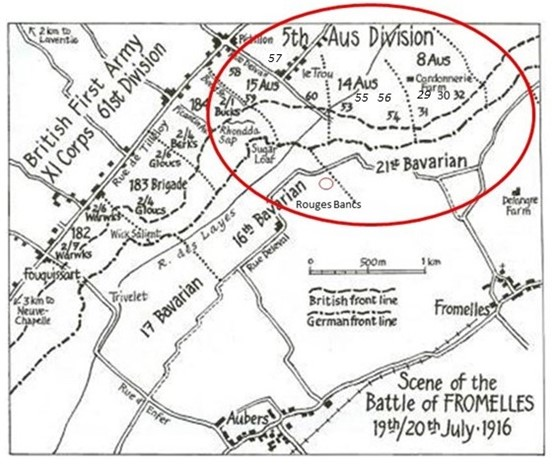
The battle plan had the 15th Brigade located just to the left of the British Army. The 59th and 60th Battalions were to be the leads for this area of the attack, with the 58th and 57th as the ‘third and fourth’ battalions, in reserve. The ‘Sugar Loaf’ salient, a heavily manned position with many machine guns, was directly across from them. Fire from here could enfilade any troops advancing towards the front lines, giving the Germans a significant advantage. The 58th Battalion’s role was to be carrying ammunition, digging the communication trenches for area gained in No Man’s land and into the battle for fighting relief as needed. The Australian’s attack was planned for the 17th, but it was delayed due to bad weather.
The 59th and 60th went over the parapet at 5.45 PM on the 19th, drawing immediate and intense fire from rifles and the Sugar Loaf machine guns just a short distance away. As documented in the messages sent back to HQ just after the attacks began:
“cannot get on the trenches as they are full of the enemy”
“every man who rises is shot down”
With the severity of the German’s defence, the 58th A and B Companies were brought forward for support at 9 PM. The 15th Brigade notes on the battle captures the intensity of this part of the attack – “they were enfiladed by machine guns in the Sugar Loaf and melted away.”
At 11.15 PM the rest of the 58th were brought forward to try digging in at 100 yards from the German trench, but no further progress was reported. By 2.52 AM the soldiers from the 58th were withdrawn and replaced by the 57th. They all remained under heavy shelling until 10 AM on the 20th when the firing finally ceased. Of the 1002 men of the 58th that left Egypt, the roll call reflected 27 killed, 167 wounded and 53 were missing, including Jack. The figures for the 15th Brigade were 84 killed, 1163 wounded and 563 missing.
Ultimately the impact on the 58th was that 154 soldiers were killed or died from wounds. Of this total, 64 remain missing/unidentified. The 15th Brigade total was 951 soldiers killed. To get some perspective of the battle, when Charles Bean, Australia’s official war historian, attended the battlefield two and half years later, he observed a large amount of bones, torn uniforms and Australian kit still on the battlefield.
After the Battle
Jack was killed in action on the night of the 19 July 1916, but given the situation, was initially reported as ‘missing’. May and the family had been notified about Jack, but there was no further information that the Army could provide. Jack’s Aunt Victoria had been close to him and his sisters Olive and Myrtle and she wrote to the Army a number of times to try and ascertain what happened to him.
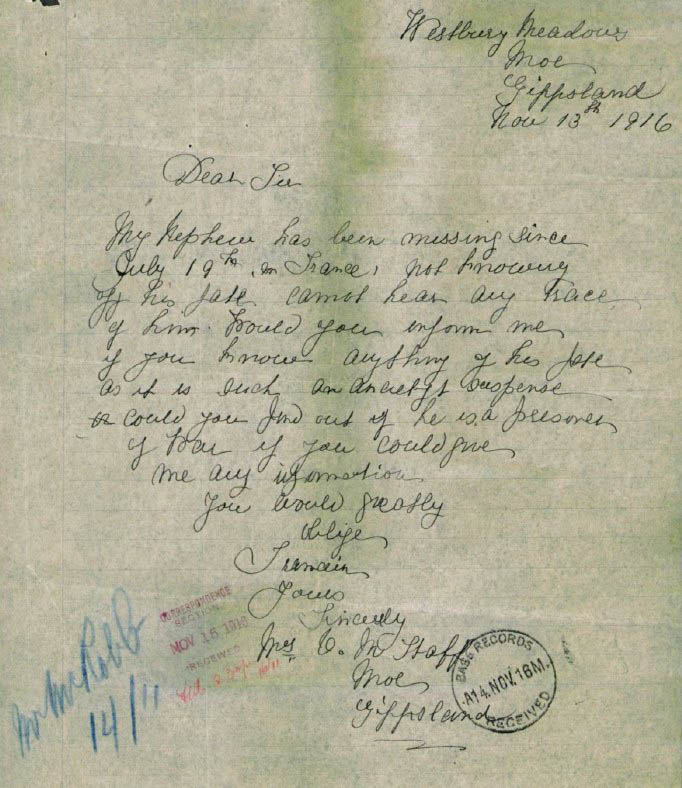
She ended her 24 March 1917 letter to the Red Cross with, “he was beloved by us all.” With no information available from any Australians, even his mate Thomas Stannard’s witness statement was not taken until December 1919, and with no record of him being a prisoner, Jack was confirmed as having been killed in action by a formal ‘enquiry in the field’ that was held on 1 September 1917.
Thomas Stannard’s witness statement showed that he was a good friend, but even he had little in the way of details of what happened to Jack:
“About 5 p.m. on July 19th 1916, all the Battalion went over the top at Fleur Bay (sic). Both of the above named (Whitehill and 3288 G. Watt) went over with Informant, but he has never heard anything of them since.”
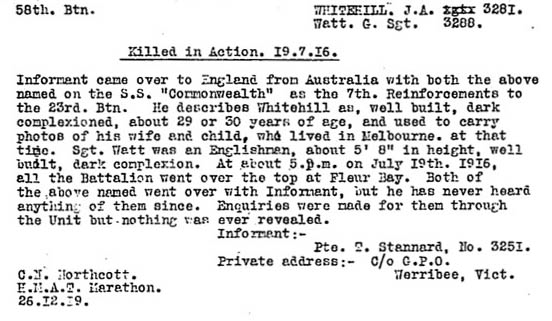
Jack remains missing to this day.
He was awarded the Victory Medal, the Star Medal, a Memorial Plaque and a Memorial Scroll and is commemorated at V.C. Corner (Panel No 14), Australian Cemetery Memorial, Fromelles, France.
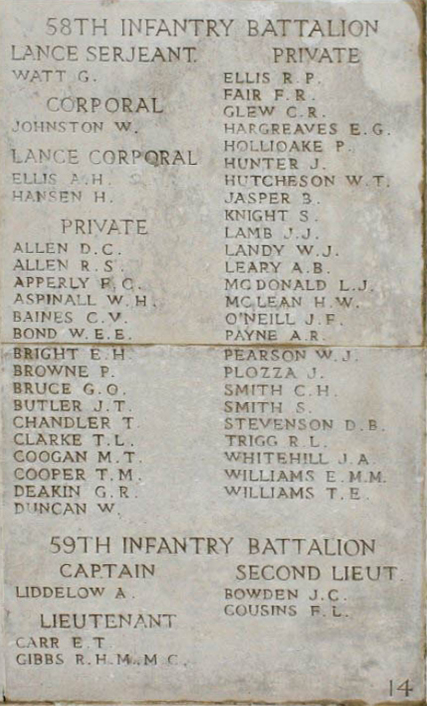
Family back home
May wrote to the War department in 1921, but there was nothing they had to offer:
“I regret saying since my husband’s death five years ago, I have never had anything whatever of his returned to me, not even a letter. I sent him a photo of his baby, he wrote and answered that but that was the last I heard from him…I have kept all the letters he wrote”
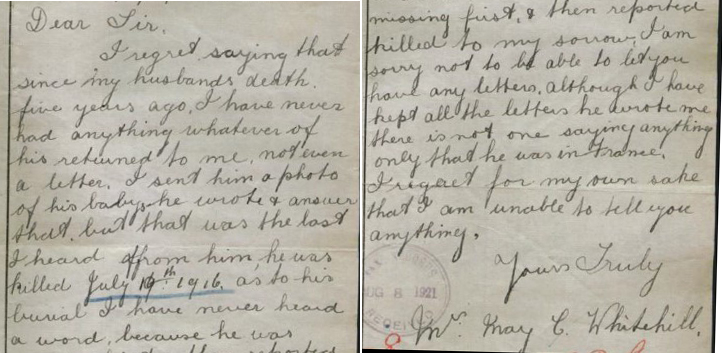
May did receive a pension from the Army which helped her to raise their young son John. Around 1920, she met and began a relationship with Percy Francis Claxton. One of Percy’s cousins, Maurice Claxton (1239) had also died at Fromelles and is buried at Pheasant Wood. May and Percy had a daughter, May Alice. Unfortunately, Percy died in 1931. May lived until 1984. John Junior followed his father’s footsteps into the Army, serving in World War 2.
He joined the Citizens Military Forces in 1940 and then served in the regular army from 1942-1945. He was posted in Bougainville, Papua New Guinea during the Australians’ involvement there. He was with the 16th Works Company that provided the infrastructure support needed for the Army’s operations. John married in 1941 and had a son and a daughter. He passed away in 1985.
Could Jack still be found?
While Jack’s body was not recorded as having been recovered, there is an undated handwritten note in his file that simply states.
This could just be a statement acknowledging that he was simply lost in the battlefield, but other soldiers do have similar statements in their files, some of which have been found to be in the Pheasant Wood burial pit. While there are only three soldiers from the 15th Brigade that have been identified so far from the 250 soldierswho were in the mass grave, as of 2024 there are still 70 remaining unidentified soldiers. Family DNA donors are needed to find out if Jack could be one of these unidentified soldiers.
No DNA samples have never been received by Army, and are being sought from family especially family of John’s parents, and his siblings.
| Soldier | John Alger Whitehill (1893-1916) married May Constance Allen (1893-1984) |
| Child | John Alger Whitehill (1916-1985) |
| Parents | Mark Hadley Whitehill (1864-1896) Victoria, Australia and Violet Louise Reid (1870-1918) Victoria, Australia |
| Siblings | Olive Clapton Whitehill (1891-1940) , m Charles Arthur Widdis McKernan | ||
| Myrtle Violet Osborne Whitehill (1895-1923) m Adolf “Harry” Promnitz | |||
| Half Brother – Horace Leslie Campbell |
| Grandparents | |||
| Paternal | John Francis Whitehill (1834-1906) Wollongong, NSW and Sarah Clapton Hadley (1839-1916) Bishopgate, England | ||
| Maternal | Alexander Reid (1831-1891) Wick, Scotland and Isabella Craig (1836-1929) Edinburgh, Scotland |
The Fromelles Association would love to hear from you

Contacts
(Contact: carla@fromelles.info or geoffrey@fromelles.info).
(Contact: army.uwc@defence.gov.au or phone 1800 019 090).
Donations
If you are able, please contribute to the upkeep of this resource.
(Contact: bill@fromelles.info ).

